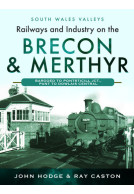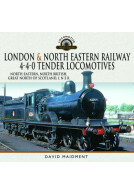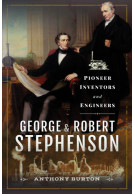Milford Haven & Neyland Branches (Hardback)
Imprint: Pen & Sword Transport
Series: West Wales Railways
Pages: 128
Illustrations: 21 colour & 255 black and white illustrations & maps
ISBN: 9781526795861
Published: 28th July 2022
(click here for international delivery rates)
Order within the next 5 hours, 14 minutes to get your order processed the next working day!
Need a currency converter? Check XE.com for live rates
Part of the West Wales Railways series, this book starts at Clarbeston Road, covers the oil-rich town of Milford Haven, where oil refineries were opened mostly in the 1960s in association with the deep-water port, to accommodate super tankers from the Middle East, though the development of other products and pipelines in the oil world has seen the number of oil terminals there currently reduced to one at Robeston.
Neyland was the original West Wales terminus of the GWR, after plans to develop Fishguard were delayed until 1906, and saw several through Passenger and Parcels trains to Paddington until 1963, when through passenger trains between Paddington and West Wales were terminated at Swansea with a DMU service beyond. The Neyland branch from Johnston was closed under the Beeching cuts of 1964, involving the closure of the important Motive Power Depot whose allocation of County Class engines is well illustrated, though the effect of this was largely nullified by the arrival of the diesel age.
As featured by
The Broad Gauge Society
This latest instalment in Pen & Sword’s West Wales Railways series, looks at the port town of Milford Haven, whose oil refineries and terminals continue to supply the country with fuel, and the now-closed route to Neyland. The book covers the route from both of these important GWR termini to Clarbeston Road, via Haverfordwest, on the Fishguard to Carmarthen mainline.
Model Rail Magazine
The author provides plenty of background information and, although the accompanying images are mostly black and white, they feature lots of fascinating detail on the railway’s infrastructure and surroundings, as well as a varied mix of GWR motive power and rolling stock. Fish traffic was a principal source of income for both Milford Haven and Neyland, until the growth of the oil industry at the former port in the 1960s. Through passenger workings to Paddington became but a memory after the mid-1960s and the Neyland route - originally the more important destination - closed completely in 1969.
Neyland’s MPD is featured at length, revealing how the depot and adjacent station would make ideal model subjects, thanks to the variety of motive power and traffic arriving there over the years.
A bunch of colour plates are also provided, bringing the story up to date with images of heavy freight workings in the post-2000s era.
John Hodge reaches the end of the line of his nine picture books of trains on the south Wales main line. The vast majority of images date from the steam-hauled 1960s but the colour section includes some more recent services to the oil refineries. There are some images of stations without trains. The portraits of locomotives on shed include sixteen of County class 4-6-0s at Neyland and the author includes a decennial analysis of that shed’s allocations from 1901 to 1961.
Railway and Canal Historical Society
This is an excellent work which adds considerably to the recorded history of the railways in this corner of West Wales.
West Somerset Railway Association
"I enjoyed the book and recommend it."
The Railway Correspondence and Travel Society - The Railway Observer, November 2022, Volume 92, Number 1125
"These less visited lines deserve more attention so this book is welcome."
Welsh Railways Research Circle Newsletter No.171, Autumn 2022
"It is very rewarding to be able to review a book where you can relate directly to the subject matter, and much more gratifying when the book is one that can be recommended as a worthy addition to the Pen & Sword catalogue."
Ffestiniog Railway Magazine - Winter 22
"A good introduction and "The light of other days" is well lit here."
Journal of the Friends of the National Railway Museum
John Hodge completes his major work on the South Wales Mainline with this volume on the last two ‘Branches’ in the far West, one, being the original terminus of the Brunel broad gauge mainline.
Richard Abbey - 6024 Preservation Society
The volume follows the same format as the previous three, first from the junction at Clarbeston Road to Milford Haven, then to Neyland covering the (mainly) 1960’s freight only branch lines to the oil refineries.
The author has pleasingly managed to find one or two early (Membership Victorian/Edwardian) photographs to include this time. Colour steam views are a bonus.
Neyland locomotive depot receives good coverage and locomotive allocation lists at ten year intervals. Numerous photographs of locomotive classes both allocated and visiting illustrate what a busy location it was.
Featured in
Welsh Railways Research Circle Newsletter No.169, Spring 2022
Another nicely illustrated book from Hodge as we have come to accept.
James Simmonds
About John Hodge
The late John Hodge was a former railwayman, who started his working life on the Western Region in South Wales in 1961, later transferring to London Paddington and British Railways Board. He was brought up in Barry, a port town west of Cardiff, which has strong railway connections, once being an important port for coal traffic and later being famous for Woodham Brothers scrap yard, and which held over 200 locomotives that are now mostly preserved on heritage lines. John was a lifelong railway enthusiast and historian, with many railway histories published.























